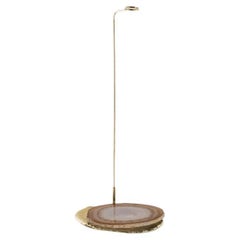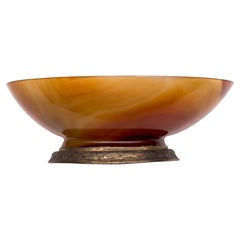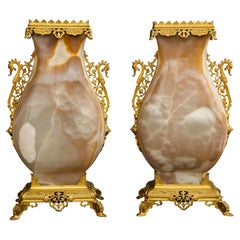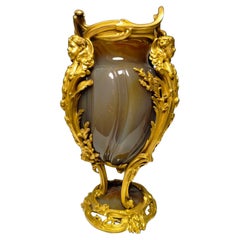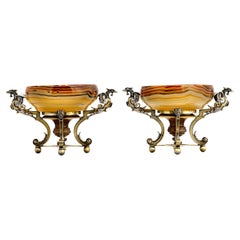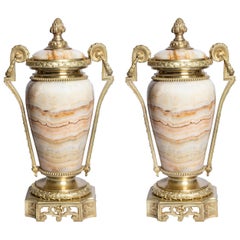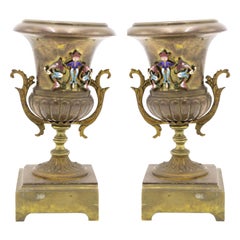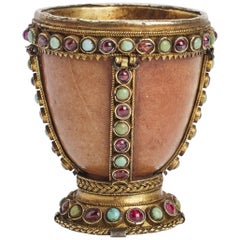Agate Vases
8
1
to
1
5
3
9
8
9
3
1
1
1
6
1
1
1
Height
to
Width
to
1,192
20,113
11,495
6,090
4,348
8
6
1
1
1
1
1
Material: Agate
Agatha - plant stand with natural agatha stone and gold brass
Located in Fânzeres, PT
Introducing Agatha, a one-of-a-kind tealight holder that doubles as a stunning decorative plant stand. Meticulously crafted using a blend of handcrafted techniques, Agatha exudes bot...
Category
2010s Portuguese Agate Vases
Materials
Agate, Gold Plate, Brass
Agate Bowl
Located in PARIS, FR
Oval cut and polished agate bowl with an engraved brass mount. The setting is decorated with cranes and plum blossoms, of Japanese inspiration.
Europe, Germany or Italy – Early 20...
Category
Early 20th Century European Agate Vases
Materials
Agate, Bronze
Large Pair of 19 C. French Ormolu Mounted Carved Agate Vases, Att. to E. Lievre
Located in New York, NY
A very large pair of 19th Century French Louis XVI Style Ormolu Mounted Carved Agate Vases, Attributed to Édouard Lièvre. Each vase is massive with a...
Category
1860s French Louis XVI Antique Agate Vases
Materials
Agate, Bronze
Exceptional French Vase in Gilt Bronze and Agathe 19th Century
Located in Madrid, ES
Exceptional French vase in Gilt Bronze and Agathe
It is a maximum luxury object made with great skill and warmth. Note the exceptional quality of the bronze and the shape of Agatha...
Category
19th Century French Baroque Antique Agate Vases
Materials
Agate, Bronze
Agate and Silver Tazzas by Jules Wiese
Located in New Orleans, LA
This stunning pair of silver and agate tazzas by prominent Parisian goldsmith and jeweler Jules Wiese exhibits a classical elegance. The warm beauty of the...
Category
19th Century French Renaissance Antique Agate Vases
Materials
Agate, Silver
Pair of Gilt Bronze and Agate Cassolettes, France, Late 19th Century
Located in Buenos Aires, Buenos Aires
Pair of gilt bronze and agate cassolettes, France, late 19th century.
Category
Late 19th Century French Neoclassical Antique Agate Vases
Materials
Agate, Bronze
Agate Cup with Jewelled and Enamelled Gold and Silver-Gilt Mounts by Morel
Located in London, GB
This exquisite work of art was created circa 1836-1840 in France by the acclaimed French gold and silversmith, Jean-Valentin Morel. Using only the finest of materials and with exceptional attention to detail, this magnificent piece is without doubt one of the finest creations within the field of decorative arts in the 19th century.
The body of the cup has been crafted from the pinky-red and orange gemstone, agate, and fitted with gold and silver-gilt mounts, which have, in some places, been jewelled and enamelled. Morel specialized in high quality hard stone cups...
Category
Early 19th Century French Renaissance Antique Agate Vases
Materials
Agate, Gold, Enamel, Silver
Rare Louis XVI Russian Ormolu Mounted Agate Vase with Dore Bronze Swan Handles
Located in New York, NY
A magnificent Louis XVI Style Russian ormolu-mounted covered agate vase or Urn with finely hand-chiseled and Cast doré Bronze Swan Handles. This marvellous baluster form covered vase...
Category
1830s Russian Louis XVI Antique Agate Vases
Materials
Agate, Bronze
Pair of French Louis XVI Period Gilt Bronze and Agate Vases
By Martin Baffert
Located in London, GB
These truly exceptional and rare antique Louis XVI period vases have been sculpted from agate, a precious and highly sought-after stone. The vases are set on square agate bases with gilt bronze laurel wreath socles. The burgundy and claret agate bodies of the vases are mounted with gilt bronze acanthus leaf ornamentation, and twin lion masks joined by draped swags above. The lids of the vases are mounted with gilt bronze, surmounted by pine cone finials.
The vases' design is attributed to the late 18th century, French clockmaker Martin Baffert. Baffert worked with a number of Parisian bronziers including Jean-Nicholas Fremont, Nicolas-Guillaume Jourdan and Francois-Robert Leguel, who assisted in the creation of his designs. This pair of vases is very similar to another pair of vases which Baffert designed, which form part of a clock garniture currently in the Rothschild collection at Waddesdon Manor. The Rothschild vases...
Category
1770s French Louis XVI Antique Agate Vases
Materials
Agate, Bronze, Ormolu
Related Items
Baré Tall Plant Stand, White Oak with Cast Bronze Tray
Located in Hamilton, ON
The Baré Tall Plant Stand is part of family of objects designed around the act of indoor horticulture. Named after Jeanne Baré, the first woman to circumnavigate the globe - each object in the series provides an elegant, elevated pedestal for your houseplants.
The Baré Tall features a cast bronze tray...
Category
21st Century and Contemporary Canadian Agate Vases
Materials
Bronze
Late 19th Century Pair of French Victorian Bronze Urns
Located in New York, NY
PAIR of French Victorian bronze urns with handles and enamel crest. (PRICED AS PAIR).
Category
Late 19th Century French Victorian Antique Agate Vases
Materials
Bronze, Enamel
19th Century French Gilt Bronze, Baccarat Crystal and Marble Cornucopia Vase
By Baccarat
Located in Pittsburgh, PA
This large cut crystal cornucopia vase terminates in a ram's head form gilt bronze mount, and is set on a black marble base.
Category
Mid-19th Century French Neoclassical Antique Agate Vases
Materials
Marble, Crystal, Bronze
H 11 in W 10.5 in D 7 in
19th Century Japanese Bronze Vase
Located in Brighton, Sussex
A very good quality Meiji period (1868-1912) Japanese patinated bronze vase, depicting two seated dogs below a Bamboo plant.
Category
Late 19th Century Japanese Japonisme Antique Agate Vases
Materials
Bronze
French 19th Century Pair of Lacquered Bamboos Japonisme Vases
Located in Saint-Ouen, FR
A 19th French century pair of Lacquered Bamboos Japonisme vases.
An amazing pair of tall cylindrical bamboo vases decorated in Japanese Gold and Sil-ver Hiramaki-E Lacquer with Pavilions in The Mist and Weaving Figures, Flown Over by a Pair of Cranes. Enclosed in a Sino-Japanese Inspiration Golden and Brown Patina Bronze Mount Featuring Elephant Heads, Partially Openwork Branches and Salamanders Forming Side Handles.
Circa 1870
Attributed to Édouard Lièvre (1828-1886) and Ferdinand Barbedienne (1810-1892)
Édouard Lièvre (1828-1886) is one of the most talented and prolific designer and industrialist of the 19th Century, his repertoire is sometimes Sino-Japanese or Neo-Renaissance, whether in furniture or works of art, we can note in particular the parade bed of Valtesse de La Bigne, furniture commissioned by the painter Édouard Detaille or even Sarah Bernhardt, and the famous works in collaboration with Maison Christofle or those in gilded bronze and cloisonné enamel edited by Ferdinand Barbedienne, presented at the Universal Exhibitions in 1878, 1889 and 1900.
He was both a draftsman, painter, illustrator, engraver, ornamentalist and cabinetmaker, first trained in the studio of the painter Thomas Couture, Lièvre was then fully immersed in the world of decoration, creation and ornamentation and provides designs for manufacturers and merchant-publishers.
Often assisted by his brother Justin, he first produced works of art for his own apartment, seeking out the finest craftsmen to execute his designs for bronzes, ceramics, fabrics and luxury furniture from great virtuosity and great taste. He then collaborated with the cabinet-maker Paul Sormani, as well as haberdasher merchants such as the Escalier de Cristal, bronziers such as Maison Marnyhac and especially Ferdinand Barbedienne as on our vases with bronze mounts characteristics of Edouard Lièvre's work.
Born in 1810, died in Paris in 1892, Ferdinand Barbedienne, the most important caster of bronze pieces of art during the second half of the 19th Century, created and directed in Par-is one of the major artistic foundries of his time. Barbedienne specialized in classical reproductions, whose models were exposed in famous European museums. Their illustrated catalogues included many diverse objects such as busts, ornemental sculpture (clocks, candelabras, cups) sometimes even life-sized and bronzes for furniture. Apart from his own produc-tion, Barbedienne worked for the most renowned sculptors such as Barrias, Clésinger and Carrier-Belleuse. All his works were highly esteemed and he, himself honored by contemporary critics. At the London exhibition in 1851 Barbedienne’s firm won two « Council medals ». At the 1855 Universal Exhibition, he won a medal of honor. The success of Barbedienne’s firm brought him many official commissions, such in about 1860, as Barbedienne supplied bronzes for furniture for the Pompeian Villa of Prince Napoléon-Joseph, located avenue Montaigne in Paris. At the London Universal Exhibition of 1862 Barbedienne won medals in three different categories: Furniture, Silversmith work and Artistic bronzes. Barbedienne was made an officer of the Légion d’Honneur in 1867 and Commander in 1878 when he was compared with « a prince of industry and the king of bronze casting ». His glory did not decline with the passage of the time for at the Universal Exhibition of 1889 the critics thanked Barbedienne for the example he set for other bronze-casters by the perfection of his bronzes.
“Japonisme” in the second half of the 19th century, was a craze for everything that came from Japan or imitated its style. The word was first coined in a series of articles published by Philippe Burty, from May 1872 to February 1873, in the French magazine “la Renaissance Littéraire et Artistique”. Far from the Academic sphere, artists seeking for new ways of expression, appropriated this discovery. Manet and the impressionists led the way to half a century of enthusiasm for Japanese art, and largely contributed to the esthetical revolution Europe experienced between 1860 and the beginning of the twentieth century.
From 1862, The World’s Fairs provoked massive arrivals of fans, kimonos, lacquers, bronzes, silks, prints and books that launched the real era of Japonisme. With those exhibitions, the demand was boosted, the number of merchants and collectors was multiplied, and artists became passionate about this new esthetic. For them, its “primitivism” was probably its most important quality: artists were fond of the Japanese art’s capacity to be close to nature and to reconcile art and society by representing, with a lot of care, the most trivial objects.
In painting, Edouard Manet, Mary Cassatt, Degas, Van Gogh, Gauguin were among those who were deeply inspired by Japanese art, affected by the lack of perspective and shadow, the flat areas of strong color, the compositional freedom in placing the subject off-center, with mostly low diagonal axes to the background. The Japanese iris, peonies, bamboos, kimonos, calligraphy, fish, butterflies and other insects, the blackbirds, cranes and wading birds, the cats, tigers, and dragons were endless sources of inspiration, appropriation, and reinterpretation for European artists. The occidental productions were combining styles and artistic conceptions instead of copying Japanese art slavishly. That is what brings to light the comparison between the artworks of Kitagawa Utamaro and Degas, of Katsushika Hokusai and Van Gogh
The World’s Fairs of 1851 and 1862 in London, those of 1867, 1878, 1889 and 1900 in Paris, of 1873 in Vienna and of 1904 in Saint Louis presented a number of “Japanese-Chinese” installations with earthenware, bronzes, screens and paintings and attracted the largest amounts of visitors In Vienna, the “Japanese village...
Category
1870s French Japonisme Antique Agate Vases
Materials
Bronze
19th c. Gilt Bronze Vase
Located in Fairfax, VA
A beautiful two color bronze vase. Crafted in France during the 19th century and featuring bronze doré, this piece is truly a work of art.
Category
19th Century French Antique Agate Vases
Materials
Bronze
Pair of 19th Century Bronze and Ormolu Tazzas
Located in London, GB
A small pair of early 19th century bronze and ormolu tazzas, having elegant scroll handles, above turned stems, raised on sienna marble plinth bases with ...
Category
Mid-19th Century Antique Agate Vases
Materials
Bronze
ClassiCon Bowl in Grey
Located in New York, NY
Hand blown glass bowl.
available in:
Quarzgrau quartz grey
Amethystviolett amethyst violet
Bernsteinorange amber orange
Smaragdgrün emerald green
Montanablau Montana blue
Saphirbla...
Category
21st Century and Contemporary German Modern Agate Vases
Materials
Blown Glass
Exquisite brass bound oak jardinieres / plant stand
Located in Bishop's Stortford, GB
An exquisite brass bound oak jardinieres / plant stand made in a barrel construction standing on square legs. Made around the turn of the 20th century in an arts and Crafts style, th...
Category
Early 20th Century British Victorian Agate Vases
Materials
Oak
Pair of 19th Century Miniature Gilt Bronze and Champlevé Enamel Vases
Located in London, GB
A pair of gilt bronze and champlevé enamel vases
Constructed from solid fire-gilded bronze, the miniature decorative vases supported on square plinths rising from paw feet, the co...
Category
19th Century French Antique Agate Vases
Materials
Bronze, Enamel, Ormolu
Baré Tall Plant Stand, Walnut with Cast Bronze Tray
Located in Hamilton, ON
The Baré Tall Plant Stand is part of family of objects designed around the act of indoor horticulture. Named after Jeanne Baré, the first woman to circumnavigate the globe - each object in the series provides an elegant, elevated pedestal for your houseplants.
The Baré Tall features a cast bronze tray...
Category
21st Century and Contemporary Canadian Agate Vases
Materials
Bronze
Bowl 002
Located in Ridgewood, NY
Hand-cast bowl for indoor and outdoor use. Can be used for planting as well; drainage holes can be added.
At the intersection of art, craft, and design, Concrete Poetics' debut co...
Category
2010s American Agate Vases
Materials
Cement, Concrete
Previously Available Items
Antique Austrian Solid Silver, Enamel and Gem Set Figural Agate Vase, circa 1880
Located in Royal Tunbridge Wells, Kent
Antique 19th century Austrian Renaissance Revival solid silver enameled and gem-set figural agate vase, the baluster agate body supported by a squ...
Category
19th Century Austrian Renaissance Revival Antique Agate Vases
Materials
Agate, Multi-gemstone, Silver, Enamel
Free Shipping
H 6.3 in W 2.17 in D 3.94 in
Agate Cup with Garnets and Turquoise, Russia, 18th Century
Located in Milan, IT
Round agate cup with clay finishes made of golden silver with garnets and turquoise, Russia, circa 1700.
Category
Early 18th Century Russian Antique Agate Vases
Materials
Agate, Brass
Important Pair of Russian Imperial Agate and Bloodstone Ormolu Mtd. Jasper Vases
Located in New York, NY
A magnificent and highly important pair of Russian Imperial Louis XVI style agate and bloodstone ormolu-mounted Jasper vases with agate and ormolu wreath finial covers. Both vases are of tapered ovoid form and mounted on the center of each body are leafy draped swags, flanked by figures of doré bronze maidens. The waisted agate socle is resting on a doré bronze leaflet ring and is above an octagonal bloodstone jasper base...
Category
Mid-19th Century Russian Louis XVI Antique Agate Vases
Materials
Agate, Bronze
H 17 in W 7.5 in L 17 in
19th Ormolu Amphore, Agate , Spanish Baroque Amphore
Located in Valladolid, ES
Amazing 19th century golden bronze ( ormolu) and agate stone Spanish Baroque style Amphore. The golden bronze has rockeries, scrolls and a medallion of the god Bacchus on the back of...
Category
1880s French Baroque Antique Agate Vases
Materials
Agate, Ormolu
Two 19th Century Russian Agate and Gilt Bronze Vases
Located in London, GB
These fine agate vases once formed part of the collection of the Astor family, American-born aristocrats after whom many New York landmarks are named, who settled at Hever Castle...
Category
Early 19th Century Russian Neoclassical Antique Agate Vases
Materials
Agate, Ormolu
Two Antique Russian Agate and Gilt Bronze Vases
Located in London, GB
These charming agate vases are delicate in size and elegant in proportion, and were formerly in the important collection of Lord Astor of Hever, the famed English publisher of the Times.
The vases feature curved, ovoid bodies with waisted necks and covers. The way that the agate has been sensuously cut and polished highlights the banded translucence and variation of colour that this semi-precious stone is prized for. The bodies are mounted with twin swan handles in gilt bronze, which are joined by leafy swags. Each cover sits on a beaded, banded rim of gilt bronze and is surmounted with a berried finial gilt...
Category
Early 19th Century Russian Neoclassical Antique Agate Vases
Materials
Agate, Ormolu
19th Century French Agate and Enamel Vase
Located in Paris, FR
Agate vase decorated with long, fluted canals, gadroons, and an enamel frame adorned with interlacing and flowering scrollwork. The vase is crowned with multicolored flowers and rest...
Category
19th Century French Louis XV Antique Agate Vases
Materials
Agate, Enamel
Viennese Agate and Jeweled Asian TOTEM Vase
Located in New Orleans, LA
Masterfully handcrafted with clear influences of Chinese culture, this rare and unique agate and jeweled vase demonstrates Viennese command of the decora...
Category
19th Century Austrian Other Antique Agate Vases
Materials
Agate, Silver
Antique Austrian Solid Silver, Enamel and Gem Set Figural Agate Vase, circa 1880
Located in Royal Tunbridge Wells, Kent
Antique 19th century Austrian Renaissance Revival solid silver enameled and gem-set figural agate vase, the baluster agate body supported by a squ...
Category
19th Century Austrian Renaissance Revival Antique Agate Vases
Materials
Agate, Multi-gemstone, Silver, Enamel
Free Shipping
H 6.3 in W 2.17 in D 3.94 in
Recently Viewed
View AllMore Ways To Browse
Bottle Warmer
Ceramic Bird Shapes
Chinese Bronze Dragon Antique
Flower Bud Vase
Japanese Hand Mirror
Pair Of Bathroom Mirrors
Jar With Vase Metal Vase
Dark Blue Porcelain Vase
Pair Of Gilded Bronze Vases
Murano 5 Vases
Possibly Irish
Large Rustic Vessel
Tall Clear Blown Glass Vase
Antique Celadon Vase
French Studio Art Pottery
Murano Gold Fleck Vase
Facet Vase Crystal
Wooden Jar Lid
